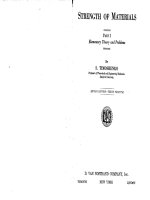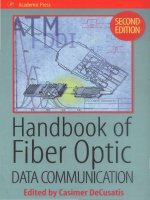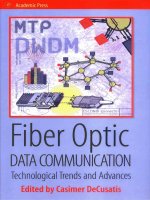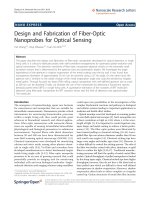decusatis, c. (2002). handbook of fiber optic data communication (2nd ed.)
Bạn đang xem bản rút gọn của tài liệu. Xem và tải ngay bản đầy đủ của tài liệu tại đây (38.01 MB, 854 trang )
DATA
COMMUNI(ATI0N
HANDBOOK
OF FIBER OPTIC
DATA
COMMUNICATION
HANDBOOK OF
FIBER OPTIC
DATA COMMUNICATION
Second
Edition
CASIMER
DeCUSATIS
Editor
IBM
Corporation
Poughkeepsie, New York
ACADEMIC
PRESS
An Elsevier Science Imprint
San
Diego
London
Boston
New York Sydney Tokyo Toronto
This
book is prhted on acid-free paper.
@
Copyright
0
2002,1998
by Academic
Press
All
rights reserved.
No
part of
this
publication may be reproduced or transmitted in any form or by any means,
electronic or mechanical, hcluding photocopy, recording, or any information storage and
retrieval system, without permission in writing from the publisher.
Requests for permission to make copies of any part of the work should be mailed to the fol-
lowing address: Permissions Department,
Harcourt,
Inc.,
6277
Sea Harbor Drive, Orlando,
Florida
32887-6777.
The appearance of the code at the bottom of the first page of a chapter in
this
book indicates
the Publisher’s consent that copies
of
the chapter may be made for personal or internal use
of specific clients. The consent is given
on
the condition, however, that the copier pay the
stated per copy fee through the Copyright Clearance Center, Inc.
(222
Rosewood Drive,
Danvers, Massachusetts
01923),
for copying beyond that permitted by Sections
107
or
108
of the U.S. Copyright Law.
This
consent does not extend to other kinds of copying, such
as copying for general distribution, for advertising or promotional purposes, for creating
new collective works, or for resale. Copy fees for
pre-2002
chapters
are
as shown
on
the
title pages.
If
no fee code appears
on
the title page, the copy fee is the same
as
for current
chapters.
$35.00
Explicit permission from Academic Press is not required to reproduce a maximum of
two
figures or tables from an Academic Press chapter
in
another scientific or research publication
provided
that
the material has not been credited
to
another source and that full credit
to
the
Academic
Press
chapter is given.
ACADEMIC
PRESS
An
Elsevier Science Imprint
525
B
Street, Suite
1900,
San Diego, CA
92101-4495,
USA
ACADEMIC
PRESS
LIMITED
An
Elsevier Science Imprint
Harcourt Place,
32
Jamestown Road, London
NW17BY,
UK
Library
of
Congress Catalog Card Number:
2001095438
International Standard
Book
Number:
0-12-207891-8
Printed in China
02
03
04
05
RDC
9
8
7 6
5
4
3
2
1
To
the people who give meaning to my life
and taught me to
look
for
wonder in the world:
my wife, Carolyn, my daughters, Anne and Rebecca, my parents,
my godmothel; Isabel, and her mother;
Mrs.
Crease.
-
CD
Contents
Contributors
Preface
to
the Second Edition
Part
1
The
Technology
Chapter
1
Optical Fiber, Cable, and Connectors
Ulf
L.
Osterberg
1.1. Light Propagation
1.2. Optical Fiber Characterization
1.3. Cable Designs
1.4. Connectors
1.5. Optical Fiber Bragg Gratings
References
Chapter
2
Optical Sources: Light-Emitting Diodes
and Laser Technology
Wenbin Jiang and Michael
S.
Lebby
2.1. Introduction
2.2. Technology Fundamentals
2.3. Device Structure-LED
2.4. Device Structure-Lasers
References
Chapter
3
Detectors for Fiber Optics
Carolyn
J.
Sher DeCusatis and Ching-Long (John) Jiang
3.1. Introduction
3.2.
Detector Terminology and Characteristics
3.3. PN Photodiode
3.4. PIN Photodiode
3.5. Other Detectors
3.6. Noise
3.7. Conclusions
References
xiii
xv
3
3
16
26
29
32
38
41
41
42
50
52
80
89
89
90
95
98
106
119
124
125
viii
Contents
Chapter
4
Logic and Drive Circuitry
Ray
D.
Sundstrom and Eric
Maass
4.1. System Overview
4.2. Electrical Interface
4.3. Optical Interface
Chapter
5
Optical Subassemblies
Herwig Stange
5.1.
5.2.
5.3.
5.4.
5.5.
5.6.
5.7.
5.8.
Function of the Optical Subassembly
Basic Properties of the Transmitter OSA
Basic Properties of the Receiver OSA
Coupling Radiation from a Laser Diode into a Fiber
Coupling Radiation from a Fiber into a Photodetector
Packaging of Optical Subassemblies
Optical Subassemblies for Parallel Optical Links
Outlook
References
Chapter
6
Fiber Optic Transceivers
Michael Langenwalter and Richard Johnson
6.1.
6.2.
6.3.
6.4.
6.5.
6.6.
6.7.
6.8.
Introduction
Technical Description of Fiber Optic Transceivers
The Optical Interface
Noise Testing of Transceivers
Packaging of Transceivers
(TRX)
Series Production of Transceivers
Transceivers
Today
and Tomorrow
Parallel Optical Links
References
Part
2
The
Links
Chapter
7
Fiber Optic Link Requirements
Casimer DeCusatis
7.1. Introduction
7.2.
Link
Budget Planning
7.3. Link
Planning
Considerations
Appendix A: Contact Information for Optoelectronics
and Fiber Optics Information
127
1 27
131
132
143
143
144
145
146
150
152
154
156
158
159
159
168
173
182
189
195
20 1
207
213
217
217
229
258
276
Contents
Appendix
B:
Some Accredited Homologation Test Labs
References
Chapter
8
Planning and Building the Optical Link
R.
T.
Hudson,
D.
R.
King,
T.
R. Rhyne,
and
T.
A.
Torchia
8.1.
Introduction
8.2.
Private Networks
8.3.
Standards
8.4.
Handling and Installing Fiber Optics
References
Chapter
9
Testing Fiber Optic Local Area Networks (LANs)
Jim Hayes and Greg LeCheminant
9.1.
9.2.
9.3.
9.4.
9.5.
9.6.
9.7.
9.8.
9.9.
9.10.
9.11.
9.12.
9.13.
9.14.
9.15.
9.16.
9.17.
Fiber Optic Testing Defined
Practical Considerations
Component Testing
Standardization of Testing Procedures
Fiber Optic Test Equipment Needed for Testing
Measuring Optical Power
Testing Loss
Testing Cable
Loss
OTDR Testing
Troubleshooting Hints for the Cable Plant
Special Test Considerations for Gigabit Multimode Networks
Cable Plant
Loss
with
Laser Sources
Bit Error Ratio Measurements
Characterizing Digital Communications Waveforms
Testing and Troubleshooting Networks
Transceiver Loopback Testing
Conclusion
Part
3
The
Applications
Chapter
10
Introduction to Industry Standards
Schelto
Van
Doom
10.1. Introduction
10.2.
Why
Are
International Standards Needed?
10.3.
IS0
10.4.
An
Introduction to ANSI
10.5.
IEEE
802.32
(Gigabit Ethernet)
ix
285
287
292
291
293
310
320
332
333
333
335
338
339
339
34 1
342
344
346
348
348
352
353
356
36 1
363
363
367
367
369
370
370
374
x
Contents
Chapter 11 Intramachine Communications
John
D.
Crow
and Alan
E
Benner
11.1.
11.2.
11.3.
11.4.
11.5.
11.6.
11.7.
11.8.
Introduction
Current Intramachine Optics Applications
System Area Networks
SAN
Physical Layer Technology Requirements
Copper vs Optical: Technology Trade-offs
Parallel Optical Interconnect Hardware
Examples of Parallel Optical Interconnect Links
Conclusions
References
Chapter 12 Applications: Asynchronous Transfer Mode
and Synchronous Optical Network
Carl Beckmann
12.1.
Introduction
12.2.
SONET
12.3.
ATM
References
Chapter
13
Fibre Channel
Standard
Alan
I;:
Benner
13.1.
Introduction
13.2.
Overview
13.3.
Storage
Area
Networks
13.4.
13.5.
Summary
How Fibre Channel Leverages Optical Data Communications
Web Resources and References
Chapter 14
Enterprise Systems Connection Fiber Optic
Link
Daniel
J.
Stigliani,
JI:
14.1.
14.2.
14.3.
14.4.
14.5.
14.6.
14.7.
14.8.
14.9.
Introduction
ESCON System Overview
ESCON Link Design
Multimode Physical Layer
SingleMode Physical Layer
Planning and Installation of
an
ESCON Link
Loss Budget Analysis
Link Troubleshooting
Additional Aspects
References
379
379
381
383
389
393
398
419
43
1
432
435
435
441
450
463
464
464
465
498
498
503
503
506
506
508
515
523
529
535
546
55
1
556
562
Contents
xi
Chapter
15
Local Area Networks, Fiber Distributed Data
Interface, Ethernet,
and
Token Ring
Rakesh Thapar
15.1.
Introduction
15.2.
Fast Ethernet
15.3.
Gigabit Ethernet
15.4.
VG-Any
LAN
15.5.
FDDI
15.6.
FDDI-II
References
Part
4
The
Manufacturing Technology
Chapter
16
Semiconductor Laser
and
Light-Emitting Diode Fabrication
Wenbin Jiang and Michael
S.
Lebby
16.1.
Introduction
16.2.
LED
Fabrication
16.3.
Material Growth
-
Lasers
16.4.
Device Processing
16.5.
Conclusion
References
Chapter
17
Receiver, Laser Driver, and Phase-Locked
Loop Design Issues
Dave Siljenberg
17.1.
Introduction
17.2.
Fiber Optic Receivers
17.3.
Laser Drivers
17.4.
Clock Recovery and PLLs
17.5.
Conclusion
References
Chapter
18
Packaging Assembly Techniques
Glenn Raskin
18.1.
Packaging Assembly
-
Overview
18.2.
First-Level Interconnects
18.3.
Package Types
18.4.
Package
to
Board Attach
18.5.
Optical Interconnect
References
564
564
565
571
572
587
598
599
603
603
603
605
616
642
644
655
655
655
658
664
673
673
675
675
677
688
692
695
698
xji
Contents
Chapter
19
Alignment Metrology and Techniques
Darrin
P
Clement, Ronald
C.
Lasky,
and Daniel Baldwin
19.1.
Introduction
19.2.
Interface Definition and Importance
19.3.
Light Coupling
19.4.
Elements of Coupled Power
19.5.
Alignment Techniques
19.6.
Conclusion
References
Appendix
A
Measurement Conversion Tables
Appendix
B
Physical Constants
Appendix
C
Index of Professional Organizations
Appendix
D
OS1 Model
Appendix
E
Network Standards and Documents
Appendix
F
Data Network Rates
Appendix
G
Other Datacom Developments
Acronyms
Glossary
Index
699
699
699
70
1
703
715
730
732
735
737
738
740
74
1
744
754
759
778
803
Contributors
Numbers
in
parentheses indicate the pages
on
which the authors’
contributions
begin.
Daniel Baldwin
(699), Manufacturing Research Center, School of Mechanical
Engineering, Georgia Institute of Technology,
8
13 Ferst Drive Northwest,
Atlanta, Georgia 30332
Carl Beckmann
(435), Thayer School of Engineering,
8000
Cummings Hall,
Dartmouth College, Hanover, New Hampshire 03755
AlanF. Benner
(379,464), IBM Corporation, 2455
South
Road, MS P967, Pough-
keepsie, New York 12601
Darrin
P.
Clement
(699), Maponics, 468 Garey Road, East Thetford, Vermont
05043
John D. Crow
(379), IBM Corporation, Thomas J. Watson Research Center, York-
Carolyn J. Sher DeCusatis
(89), formerly from Lighting Research Center, Rens-
Casimer DeCusatis
(217), IBM Corporation, 2455 South Road, MS P343, Pough-
Jim Hayes
(333). Fotec, Incorporated, 151 Mystic Avenue, Suite 7, Medford,
R.
T.
Hudson
(292), Siecor Corporation,
800
17th Street Northwest, Hickory,
Ching-Long (John) Jiang
(89), Amp Incorporated, Lytel Division, MS 300-001,
61 Chubb Way, Post Office Box 1300, Somerville, New Jersey 08876
Wenbin Jiang
(41, 603), Phoenix Applied Research Center, Motorola, Incorpo-
rated, 2100 East Elliot Road, MS EL703, Tempe, Arizona 85284
town Heights, New York 10598
selaer Polytechnic Institute, Troy, New York 12180
keepsie, New York 12601
Massachusetts 02155
North Carolina 28601
xiii
xiv
Contributors
Richard Johnson
(1 59),
Infineon Technologies North America Corporation,
1730
D. R. King
(292),
Siecor Corporation,
800 17th
Street Northwest, Hickory, North
Michael Langenwalter
(159),
Infineon Technologies AG, Fiber Optics Division,
Ronald C. Lasky
(699),
Consultant,
26
Howe Street, Medway, Massachusetts
Michael
S.
Lebby
(41,603),
Phoenix Applied Research Center, Motorola, Incor-
Greg LeCheminant
(333),
Hewlett-Packard, Santa Rosa Systems Division, Santa
Eric
Maass
(127),
Motorola, Incorporated,
2 100
East Elliot Road, Tempe, Arizona
Ulf
L.
Osterberg
(3),
Thayer School of Engineering,
Dartmouth
College,
Glenn Raskin
(675),
Motorola, Incorporated,
2501
South
Price Road,
M/D
G651,
T. R. Rhyne
(292),
Siecor Corporation,
800 17th
Street Northwest, Hickory, North
Dave Siljenberg
(655),
IBM Corporation,
3605
Highway
52
North, Rochester,
Herwig Stange
(143),
Infineon Technologies, Fiber Optics,
13623,
Berlin, Ger-
Daniel J. Stigliani, Jr.
(506),
IBM
Corporation,
2455 South
Road, Poughkeepsie,
Ray D. Sundstrom
(127),
Motorola, Incorporated,
2501 South
Price Road,
M/D
Rakesh Thapar
(564),
Marconi, Warrendale, Pennsylvania,
15086
T.
A.
Torchia
(292),
Siecor Corporation,
800
17th
Street
Northwest, Hickory,
Schelto Van Doorn
(367),
Siemens Corporation, Santa Clara, California
95054
North First Street,
San
Jose, California
95112
Carolina
28601
Wernerwerkdamm
16, D-13629,
Berlin, Germany
02053
porated,
2100
East Elliot Road, MS
EL703,
Tempe, Arizona
85284
Rosa, California
95403
85284
Hanover, New Hampshire
03755
Chandler, Arizona
85248
Carolina
28601
Minnesota
55901
many
New York
12601
G235,
Chandler, Arizona
85248
North Carolina
28601
Preface to the Second Edition
SONET’
on
the
Lambdas’
(by
C.
DeCusatis, with sincere apologies to Milton3)
When
Z
consider how the light is bent
Byjbers glassy in this Web World Wide,
Tera- and Peta-, the bits
Jly
by
Are they
from
Snell and Maxwell sent
Or
through more base physics, which the Maker presents
(lambdas
of
God?)
or
might He come to chide
“Doth God require more bandwidth, light denied?”
Consultants may
ask;
but Engineers to prevent
that
murmul;
soon reply “The Fortune e-500 do not need
mere light alone, nor its interconnect; who requests
this data,
if
not clients surjing the Web?” Their state
is
processing, a billion MIPS
or
CPU cycles at giga-speed.
Withoutfiber optic links that never rest,
The servers also
only
stand and wait.
When the first edition of this Handbook was published, the world
of
op-
tical data communication appeared to be already well established, and its
technology was a major driving force in the development of computers
(both servers and clients), storage, and real-world applications in business,
education, transportation, and many other sectors of the economy. Even
so,
we recognized at the time that the revolution in optical communications
was only just beginning. Today, at the dawn of a new millennium, there
are tremendous opportunities for growth in this field, and we have seen
the pace of new technology accelerate even further in recent years. These
many new developments, coupled with the success
of
the first edition, led
to the conclusion that the time was right to update and expand on
this
Handbook.
Synchronous
Optical Network
*The Greek symbol “lambda” or
h
is commonly used
in
reference
to
an
optical wavelength
3The original author of the classic sonnet
“On
his blindness”
xv
xvi
Preface
The intervening period has seen many significant changes, which re-
quired updating the original chapters; new types of lasers and photodetec-
tors, a new physical layer interface for ESCON, new packaging technology
for parallel optics, and many more revisions too numerous to mention have
been included. Many new chapters have also been added to address the
rapidly accelerating rate of change which has characterized wavelength
multiplexing, optically clustered servers, small form factor connectors and
transceivers, special types
of fiber optic cable, and other areas which would
have been classified as emerging technologies only a short while ago. Open
standards, which to a great extent have created the Internet and the Web (re-
member TCPAP?) also continue to evolve, and new standards are emerging
to deal with the requirements of the next-generation intelligent optical in-
frastructure; some
of these standards, such as MPLS and Infiniband, have
been added to this edition. There are
also
new chapters on the history
of communications technology (with apologies to those who have noted
that it remains difficult to determine exactly who invented the first one of
anything, and that the history of science is filled with tales
of
misplaced
credit). There are
also
new predictions of the future, as envisioned by some
of the leading commercial technology forecasts. Since the fist edition, De-
Cusatis’ Law has continued to hold; available data suggests that high-end
network bandwidth will continue to grow at this pace for the foreseeable
future. Indeed, the proliferation
of new optical interfaces has led the ed-
itor to coin the Law of Cable Growth,
also
known as the First Corollary
to DeCusatis’ Law: the development
of each new type of optical connec-
tor interface will proliferate
2
orders of magnitude in new cable assembly
types. For example, if you happen to be
a
supplier
of
fiber optic cables,
each new connector interface needs to be offered with
3
different fiber
types (single mode,
50
micron multimode, and
62.5
micron multimode),
2
or
3
different cable jacket types (riser, LSZH, and plenum),
5
or
6
standard
lengths for common applications, and hybrid cables
or
adapter kits that
are backward-compatible with
all
the previous types of optical connectors.
Thus, one new optical connector easily drives a hundred new cable assem-
blies! We’ve attempted to create a guide to the increasing complexity
of
optical cabling, and many other areas as well. Jargon and buzzwords in
the industry have also continued to grow; when the first edition was pub-
lished, not too long ago, nobody hew what a
SAN
or NAS was, let alone
the difference between them. Today, a resurgence
of
interest in Storage
Area Networks and Network Attached Storage has made these and many
other acronyms commonplace, but
our
readers have expressed their ongoing
Preface
wii
frustration at repeatedly encountering AUA (another useless acronym).
In
an effort to help, we've included a new glossary and table of acronyms in
this
edition, as well as an expanded index.
Today's business initiatives are inexorably linked to network bandwidth;
after
all,
your business can only grow as fast as information can be ex-
changed and acted upon. Perhaps this is why leading analysts tell us
worldwide bandwidth demand grew roughly
200%
from 1998 to
2000,
and will increase more than
400%
before
2002.
The statistics of bandwidth
growth are truly astonishing. It has been estimated that the entire Library of
Congress can be stored in about
17
TeraBytes of disk space; this is also the
current size of the package tracking database at United Parcel Services. In
July
2000,
the communication platform at the Web search engine Yahoo!
delivered
4.4
billion messages and averaged
680
million page views per
day.
In
the Information Economy, the Fortune 1000 companies are expected
to add over
150
TeraBytes of storage capacity by
2003.
Simply put, the
demand for bandwidth exceeds the supply. And this is just the beginning;
even today, less than
25%
of these companies have electronic transaction
capabilities over the Web, and even less are enabled for true e-business
applications. And a recent University of California study, having estimated
that the entire human race has accumulated about one exabyte
(1018)
of
information to date, goes on to predict that the second exabyte will be gener-
ated within the next
3
years. In this environment, we are beginning to see the
promise of all-optical networking emerge
-
application-neutral, distance-
independent, infinitely scalable, user-centric networks that catalyze real-
time global computing, advanced streaming multimedia, distance learning,
telemedicine, and a host of other applications. We hope that those who build
and use these networks will benefit in some measure from this book.
An undertaking such as
this
would not be possible without the concerted
efforts
of
many contributing authors and a supportive
staff
at the publisher,
to
all
of whom
I
extend my deepest gratitude. The following associate
editors contributed to the first edition of the Handbook of Fiber Optic
Data Communication: Eric
Maass,
Darrin Clement, and Ronald Lasky.
As
always, this book is dedicated to my parents, who first helped me see the
wonder in the world; to the memory
of
my godmother Isabel; and
to
my
wife, Carolyn, and daughters Anne and Rebecca, without whom
this
work
would not have been possible.
Dr. Casimer DeCusatis, Editor
Poughkeepsie, New York
Part
1
The Technology









